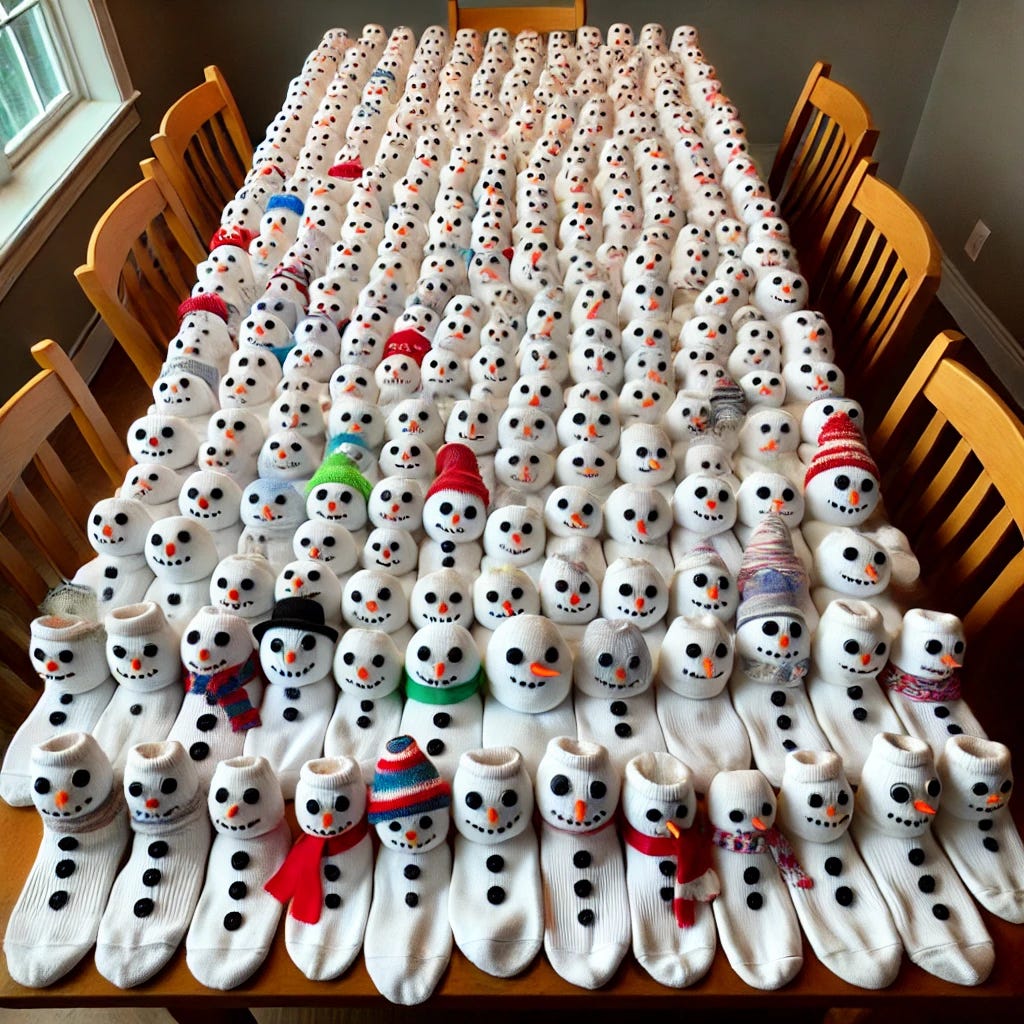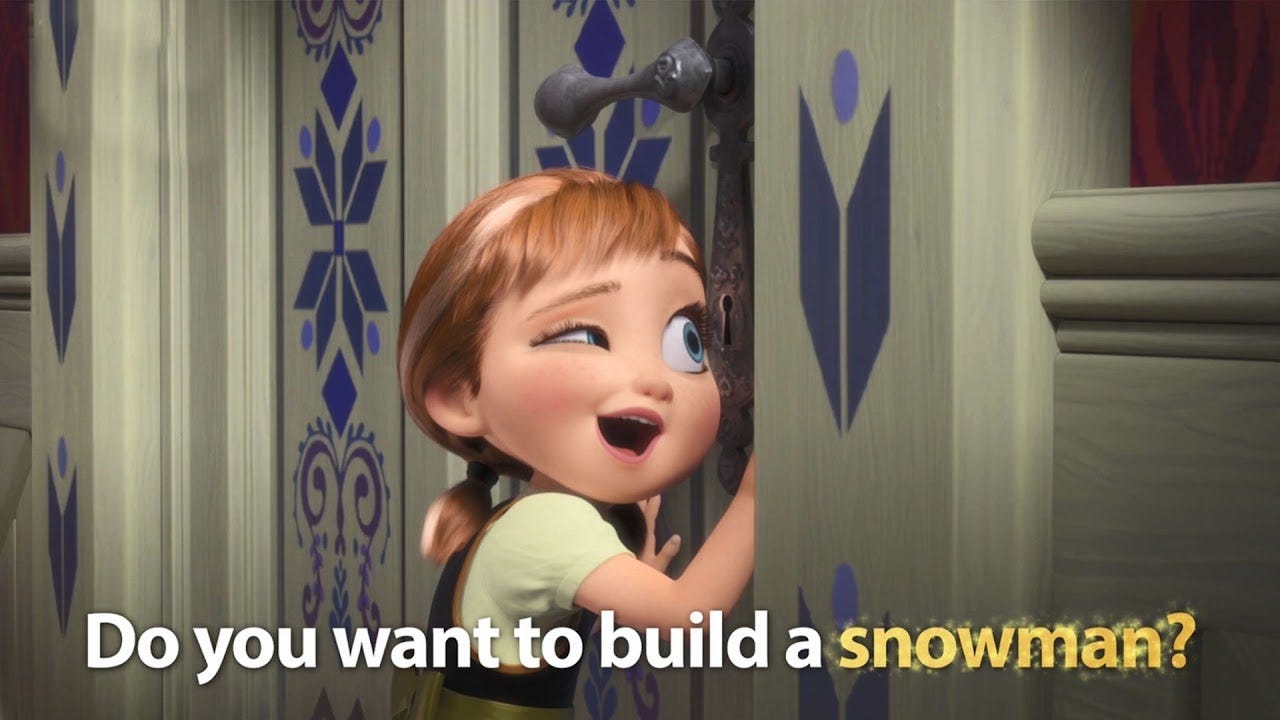I came down to the basement and turned on the lights. And I saw them: Sweat-sock snowmen. So. Many. Sweat-sock snowmen. How did they get there? What did they want? Blood? Sweat? Feet?!
My mother had called these monstrosities into being. They weren’t there for my bloody, sweaty feet, though. They were one of Mom’s creative outlets.
My mom, Linda Fisher, was an elementary school principal (shoutout to Jackson Elementary in Everett, Washington!). The snowmen were gifts for her staff. More like this:

Growing up, our house was always filled with crafty projects like the sweat sock snowmen. We had a small room devoted to crafts, with enough fabric, ribbon, hot glue, and embossing kits to last several lifetimes. I had all manner of elaborately sewn Halloween costumes throughout my childhood, as well as other homemade costumes to dress up in.
In a literal sense, my mom was creative. She sewed, did crafts, and played piano. She literally created things.
But my mom was also a rule-follower. She followed recipes to the letter (I still have laminated note cards of all her recipes that she painstakingly typed out). Her crafty creations were also rote - she’d find instructions, then follow them skillfully. She rarely invented new designs.
So here’s the question: Are these “creative outlets” truly creative, in the technical sense? To find out, we need to dive a bit deeper into what we mean by the word creative.
Defining creativity is important because the world is full of confusing information about what promotes creativity. It’s not just myths like creativity is an innate capability of lone geniuses. If you want creativity in your work and life, you are faced with contradictions. People are more creative when they are in a good mood. No, wait — people are more creative in a moderately negative mood. You need to be in a flow state, with lot’s of high quality, uninterrupted time. Hold on - actually, interruptions can promote creativity.
I’ll come back to these contradictions in later issues. But to really understand them, we need to first interrogate a paradox at the heart of the definition of creativity.
Like it or not, we need to define creativity if we want to science it up. To quote myself quoting my old solfege teacher Paul Burdick, “The magic is in the details…The more you learn about theory and technique, the more you understand the parts that aren’t magical. And that brings you closer to the real magic.” So define creativity, we must.
Luckily, most scholars agree on a basic definition of creativity: Creativity is the production of novel and useful ideas, products, processes, or services. The “ideas, products, processes, or services” part is a catch-all - it is just meant to encompass anything one could create. Some people stop the definition at the word “ideas” because creativity can be as weird, ephemeral, and conceptual as you want. You don’t have to build a snowman.
The legs on which creativity stands are in the first part of the definition: novelty and usefulness. Novelty is literally about being new, rare, or unique — something unfamiliar to the context.
Usefulness is a little more misleading. Sometimes, we mean literal usefulness for solving a problem or giving people stuff they want. Like antibiotics, Sticky Notes, or TikTok. But, other times, in place of “usefulness,” the word “appropriateness” might be more…appropriate. It feels weird to describe art, music, or literature as “useful.” But don’t stress about the distinction between useful and appropriate - you can safely use them interchangeably when defining creativity.
You can’t just focus on novelty when defining creativity because it lets all kinds of weird, useless stuff into the definition. For instance, we are making novel sounds all the time: grunting, dropping things, scraping utensils on our dinner plates. We could use them to make a novel combination of sounds pretty easily! Between the magpies, seagulls, and foxes that hang out in my back yard, I hear novel sound combinations all the time. But, for the most part, we don’t want those novel sound combinations—grunting plate scraping, or animal cacophony—streaming through our headphones. Most novel sound combinations aren’t appropriate for our musical needs. Therefore, something that is novel but not appropriate/useful doesn’t fit into the “creativity” bucket.
We need both novelty and usefulness to define creativity. More formally, novelty and usefulness are each necessary, but not sufficient, for creativity. Something highly useful, but not very novel, isn’t very creative. Neither is something highly novel, but not very useful.
But here’s why you can spend a lifetime studying creativity: novelty and usefulness often don’t play nice with each other. Making something more useful often means making it less novel, and vice versa. Let’s say, for whatever reason, you wanted a more creative chocolate chip cookie. So you decide to use cornflour and put chocolate foam on after baking instead of the usual wheat flour and chocolate chips. More novel? Sure. But wheat flour holds together better. And foam doesn’t last long or travel well - it will just soak in. So you end up trading some usefulness to introduce your novelty.
It’s the same story when we talk about almost anything - designing a new app, writing a creative sentence, making creative music. When you stray from the beaten path, you often find out why people beat the path in the first place. But, if you never stray, you never find out what’s out there and you never get creative.
Creativity is hard—and interesting—because of the paradox of novelty and usefulness. Generating an idea that is both novel and useful is rare and difficult. It’s a product of effortful trial-and-error, cognitive flexibility, and deep knowledge about how things work.
Back to the beginning: Was my Mom being creative when she made those sweat-sock snowmen, following someone else’s design?
If we focus only on the outcome, my mom didn’t produce a novel idea. She didn’t come up with the idea, nor the design. She skillfully followed instructions others had produced. So, not creative?
But from my mom’s perspective, these sweat-sock snowmen were novel and useful. She hadn’t done it before. I doubt her staff had seen or received one before. So, for the people who were actually involved, it was novel. And, the snowmen served their functions - they were well-made, conveyed her gratitude for her staff, and love of cutesy crafts. So, perfectly appropriate as well. Creative?
These two perspectives — an omniscient perspective focused on the novelty and usefulness of the outcome and an idiosyncratic, experiential perspective that characterizes the creator’s experience — are the source of a lot of confusion about creativity. That’s true in the scholarly world, and its also true for advice about how to be more creative.
When you read advice about being more creative - here on Substack and in the wider world - many people aren’t clear with themselves about which perspective they are taking or why. The outcome perspective leads to advice about motivation, skill acquisition, and evaluation biases. It is helpful if you run an organization and need new and useful ideas. Or if you approve patents or do intellectual property law. In these situations, an evaluative question looms in the background: Is this truly new to the world?
The experiential perspective advises us to take risks, try new things, and manage our own fear and anxiety. As creators, we also care about the experience we have when trying to be creative. The experience of doing something new to us, of striving to create, no matter whether the outcome is new to the world. And one of the most reliable ways to destroy the creative experience is to ask yourself that same question: Is this truly new to the world?
To truly understand creativity, you need both perspectives. You need the outcome perspective to understand what sparks most people’s creativity, and what undermines it. But you also need to have creative experiences in your own life, even if those experiences don’t generate useful novelty for the world. It’s one of the many fascinating paradoxes of creativity - when you try too hard, you may kill the very thing you strive for.
Why does this matter? Too much well-meaning advice on creativity overlooks the difference between outcome and experiential perspectives on creativity. For example, one of the inspirations for this post was a Guardian headline linking flow to creativity. But creative experiences like flow don’t necessarily lead to creative outcomes for the world. That doesn’t mean we shouldn’t try to promote creative experiences — they are an essential part of being human.
The important thing is to be clear with yourself about what you mean by creativity. That’s true when you are sifting through the myriad of advice on how to promote it. And I’ll help you do that in a more practical way in the next installment of the newsletter. I’m not sure how novel that idea is. After all, this is just my creative outlet.
Notes
If you want to go deep on the different relationships that novelty and usefulness can have, be sure to read this paper by fellow UCL professors and creativity scholars extraordinaire, Sarah Harvey and Jim Berry.
Harvey, S., & Berry, J. W. (2023). Toward a Meta-Theory of Creativity Forms: How Novelty and Usefulness Shape Creativity. Academy of Management Review, 48(3), 504–529. https://doi.org/10.5465/amr.2020.0110
I’ve written a few papers on the creative experience, including these, with my fabulous co-authors Frank Barrett, Ozum Demir-Caliskan, Mel Hua, and Matt Cronin:
Fisher, C. M., & Barrett, F. J. (2019). The experience of improvising in organizations: A creative process perspective. Academy of Management Perspectives, 33(2), 148–162. https://doi.org/10.5465/amp.2017.0100
Fisher, C. M., Demir-Caliskan, O., Hua, M. Y., & Cronin, M. A. (2021). Trying Not to Try: The Paradox of Intentionality in Jazz Improvisation and its Implications for Organizational Scholarship. In R. Bednarek, M. Pina e Cunha, J. Schad, & W. K. Smith (Eds.), Interdisciplinary Dialogues on Organizational Paradox: Investigating Social Structures and Human Expression, Part B (Vol. 73b, pp. 123–137). Emerald Publishing Limited. https://doi.org/10.1108/S0733-558X2021000073b009
If you want to learn more about creativity and paradox, I recommend INSEAD Professor Ella Miron-Spektor’s work on the topic. tl:dr, Embracing and accepting contradiction helps people come up with more creative ideas. She’s written about this quite a bit, but here’s a good place to start.
Miron-Spektor, E., Emich, K. J., Argote, L., & Smith, W. K. (2022). Conceiving opposites together: Cultivating paradoxical frames and epistemic motivation fosters team creativity. Organizational Behavior and Human Decision Processes, 171, 104153. https://doi.org/10.1016/j.obhdp.2022.104153







Brilliant piece, Colin. It was a thrill to read - I really appreciate your take on creativity and I’m looking forward to checking out the shared links.
Hi Colin, thanks for an interesting and thought provoking article. I have one question about the definition of creativity. When I’ve shared this definition of creativity with non-academics, many of them intuitively react negatively to the ‘useful’ part of the definition. They feel it does not ring true and somehow misses the point to associate the word ‘useful’ with some forms of creativity output, such as paintings, literature or music. They do not feel that that the purpose of art is ‘to be used’. One person even linked the word ‘useful’ with an assumption of utilitarianism!? I think there are probably many philosophical approaches to explaining the experiencing of an artistic product as ‘using it’, but a definition without this requirement might be more ‘useful’? What might be the issue with replacing the word ‘useful’ the word ‘value’? For example: ‘Creativity is the production of novel ideas, products, processes, or services that have value’. I feel this might overcome the problem, as people may be less likely to take issue with art being described as having ‘value’, than they would with it being described as being ‘useful’. What do you think?